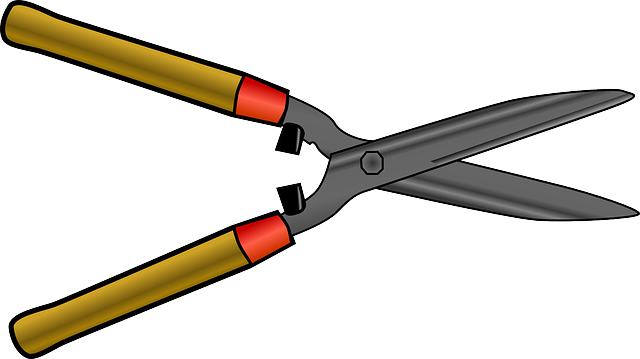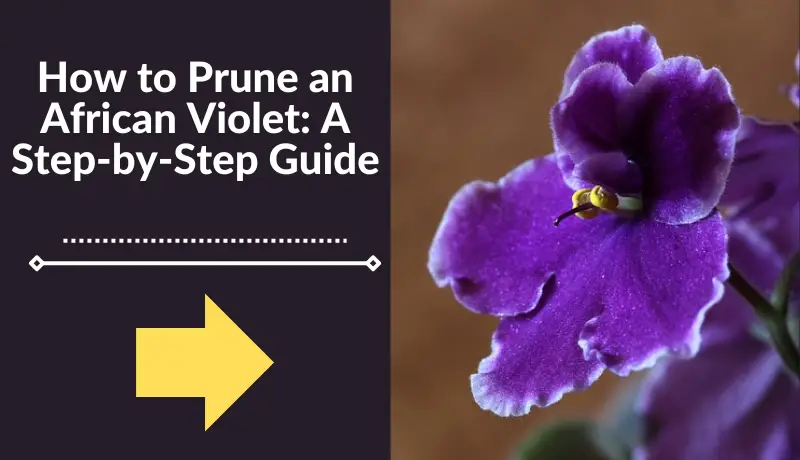African violets are beloved houseplants, cherished for their stunning flowers and beautiful foliage. As a proud African violet owner, you want to ensure that your plant thrives and continues to brighten your home with its vibrant colors.
In the following sections, we will provide you with a comprehensive step-by-step guide on how to prune your African violet, covering everything from the importance of pruning for new growth and flowering to the best tools and techniques for the job.
So let’s dive in and learn how to give your African violet the care it deserves!
Short Summary
- Pruning African violets is essential for healthy growth, flowering and maintaining shape.
- Tools used should be sharp scissors or pruning shears that have been sterilized beforehand.
- Step by step guide to pruning includes removing lower leaves, trimming spent flowers, removing damaged/diseased leaves and post-pruning maintenance such as regular watering & fertilizing.
The Importance of Pruning African Violets

Pruning your African violet is not just about keeping it looking neat and tidy; it’s also crucial for the overall health and well-being of the plant. African violets, like all living organisms, require proper care and attention to thrive, and pruning plays a significant role in ensuring that they remain healthy and vibrant.
In this section, we will explore the various benefits of pruning African violets, from promoting new growth to encouraging flowering, preventing disease, and maintaining their beautiful shape.
New Growth
One of the primary reasons for pruning African violets is to promote new growth. When you remove the lower, older leaves and any suckers (small offshoots that can steal energy from the main plant), you allow the plant to focus its resources on producing new foliage and blooms. This not only rejuvenates the plant, but also contributes to a fuller and more vibrant appearance.
When identifying suckers, look for clumps of leaves appearing at the edges of the plant rather than the center. They often hide beneath older, larger leaves, so be sure to check under the foliage for any signs of these energy-stealing culprits. To remove suckers, use a pair of scissors or tweezers to cut them off at the base, taking care not to damage the main plant.
Discovering how often to prune your African violet can be tricky. It is best to consult a professional or do research online in order to learn the optimal frequency for pruning. A good rule of thumb is to remove the bottom 3-5 leaves on a monthly basis. This will ensure that the plant continues to focus its energy on producing new growth and maintaining its overall health and appearance.
Pruning spent blooms and shaping the plant are also essential for stimulating the generation of new and healthy leaves. When you remove old flowers and maintain the plant’s shape, you create the ideal conditions for new growth to thrive, ensuring your African violet remains a stunning centerpiece in your home.
Flowering
Another important aspect of pruning African violets is encouraging flowering. By pruning spent flowers and providing proper fertilization, you create the ideal conditions for your African violet to produce an abundance of beautiful blooms. Removing spent flowers not only makes room for new blooms to emerge, but also signals to the plant that it should continue producing flowers.
Pruning can also help to prevent pests and diseases, which can hinder flowering and even damage the plant. By removing dead or diseased leaves and flowers, you eliminate potential sources of infection and create a healthier environment for your African violet to thrive. Additionally, fertilizing your plant just before or after pruning can provide it with a nutrient boost, further encouraging healthy flowering.
So, by regularly pruning your African violet and providing it with the proper care and nutrients, you can enjoy a stunning display of flowers all year round.
Disease Prevention
Pruning African violets is not only essential for promoting new growth and flowering, but also for preventing diseases that can harm the plant. By removing dead or diseased leaves and flowers, you reduce the risk of pathogens spreading throughout the plant. Furthermore, proper pruning allows for better air circulation and light penetration, which can help prevent the growth of fungi that can cause diseases.
It’s important to be vigilant when it comes to identifying signs of pests or diseases in your African violet. Stunted and discolored new leaves, as well as the presence of mites or mealybugs, can be indicators of a pest infestation. Regular pruning can help you stay ahead of these issues and keep your African violet healthy and disease-free.
By practicing proper pruning techniques and understanding the importance of disease prevention, you can ensure that your African violet remains a beautiful and healthy addition to your home.
Maintaining Shape
African violets are prized for their symmetrical and compact shape, which provides the perfect frame for their exquisite flowers. Maintaining the shape of your African violet is an essential aspect of pruning, as it not only enhances the plant’s aesthetic appeal but also contributes to its overall health.
To maintain the desired shape of your African violet, it’s important to prune a few leaves from the plant on a regular basis. This can help preserve the plant’s symmetry and restore its optimal appearance. Additionally, regular rotation of the container can help maintain the desired rounded shape by ensuring that all parts of the plant receive equal exposure to light.
By carefully pruning and shaping your African violet, you can ensure that it remains a stunning centerpiece in your home while also promoting healthy growth and flowering.
Tools for Pruning African Violets

Using the right tools for pruning your African violet is crucial for achieving the best results. Sharp scissors or pruning shears are the ideal choice for making clean cuts that will not damage the plant or introduce pathogens. Additionally, it’s essential to sanitize your pruning tools before use to prevent the spread of bacteria that can harm your African violet. To clean and disinfect your pruning tools, you can use rubbing alcohol, hydrogen peroxide, or a mixture of 1 part bleach and 9 parts water. Always ensure that your tools are clean and sharp before starting the pruning process.
While it may be tempting to pinch the foliage of your African violet as a pruning method, this is not advised for inexperienced growers. Using your fingers to pinch the leaves can introduce bacteria or cause damage to the plant. Instead, stick to using sterilized scissors or shears for the best results.
When to Prune African Violets

Knowing when to prune your African violet is essential for maintaining its health and beauty. It’s generally recommended to prune your African violet regularly throughout the year, keeping a sharp pair of pruning shears nearby for a quick trim every few weeks or months as needed. This will ensure that your plant remains in optimal condition and continues to produce vibrant foliage and blooms.
However, it’s important to note that pruning during the winter months is not recommended. During this time, your African violet is likely to experience slower growth and may be more susceptible to damage from pruning. Instead, focus on providing proper care and maintenance during the winter months, and save the pruning for the rest of the year when the plant is actively growing.
Step-by-Step Guide to Pruning African Violets
Now that we’ve covered the importance of pruning, the tools required, and when to prune your African violet, it’s time to dive into the step-by-step guide to pruning your plant. In this section, we will walk you through the process of removing lower leaves, trimming spent flowers, removing damaged and diseased leaves, and shaping the plant to maintain its stunning appearance.
Before diving into the steps, it’s crucial to have a clear understanding of your plant’s structure and shape, as well as identifying any damaged leaves, dead flowers, or potential areas of new growth. By examining your plant carefully before pruning, you can ensure that you are making the right cuts and promoting the healthiest possible growth for your African violet.
In the following subsections, we will provide more detailed instructions for each step of the pruning process, ensuring that you have all the information you need to successfully prune your African violet and keep it looking its very best.
Removing Lower Leaves
The first step in pruning your African violet is to remove the lower, older leaves. These leaves can often become discolored or damaged over time and can detract from the overall appearance of the plant. By removing these leaves, you allow the plant to focus its energy on producing new growth and maintaining its health.
To remove the lower leaves, use a sharp pair of scissors or shears and carefully cut the leaf stem as close to the main stalk as possible. Be sure not to damage the main plant, as this can cause stress and hinder the overall health and growth of your African violet.
When removing lower leaves, it’s important to avoid removing the very center leaves, as this can lead to stunted growth and a lack of new leaves or flowers. Instead, focus on the outer leaves that have become discolored or damaged, and be sure to remove them in a way that maintains the symmetry and shape of the plant.
By regularly removing lower leaves from your African violet, you can ensure that the plant remains healthy and vibrant while also promoting the growth of new foliage and blooms.
Trimming Spent Flowers
The next step in pruning your African violet is trimming spent flowers. Spent flowers are those that have finished blooming and have begun to wilt or decay. Removing these flowers is important for maintaining the overall health and appearance of your plant, as well as making room for new blooms to emerge.
To trim spent flowers, use sterilized scissors and carefully snip off the dead or dying tissue just behind the flower. It’s important to avoid ripping or tearing the flower off, as this can introduce disease or fungus into the plant. Instead, make clean, precise cuts that remove the spent flower without causing damage to the surrounding foliage.
By regularly trimming spent flowers from your African violet, you can encourage the growth of new blooms and maintain the stunning appearance of your plant.
Removing Damaged and Diseased Leaves

Another important aspect of pruning your African violet is removing damaged and diseased leaves. These leaves can harbor pathogens that can spread throughout your plant, causing further damage and potentially even killing your African violet. By removing these leaves promptly, you can help prevent the spread of disease and promote the overall health of your plant.
To remove damaged and diseased leaves, carefully examine your plant for any signs of discoloration, wilting, or other indications of damage. Use sterilized scissors or shears to cut off the affected leaves, being careful not to spread any pathogens to the rest of the plant. After removing the diseased leaves, be sure to clean your tools thoroughly to prevent the spread of disease.
By promptly removing damaged and diseased leaves from your African violet, you can help maintain its health and prevent the spread of harmful pathogens.
Shaping Your African Violet

The final step in pruning your African violet is shaping the plant. Shaping involves removing excess leaves and thinning clustered growth to maintain the desired symmetry and aesthetic appeal of your African violet. By carefully shaping your plant, you can ensure that it remains a stunning centerpiece in your home while also promoting healthy growth and flowering.
To shape your African violet, use sharp scissors or pruning shears to remove excess leaves and thin clustered growth. Make clean cuts close to the stalk, taking care not to damage the main plant. Be sure to maintain the desired symmetry as you prune, and consider rotating the container regularly to ensure that all parts of the plant receive equal exposure to light.
By following these steps, you can successfully shape your African violet and maintain its beautiful appearance while promoting healthy growth and flowering.
Post-Pruning Maintenance
After pruning your African violet, it’s important to provide proper post-pruning care and maintenance to ensure that your plant remains healthy and vibrant.
One of the key aspects of post-pruning maintenance is watering and fertilizing your African violet. African violets should be watered approximately once per week when the soil is becoming dry. Be sure to avoid overwatering, as this can lead to root rot and other issues.
Additionally, fertilize your plant with a balanced, all-purpose plant food to provide the nutrients it needs to thrive. By properly watering and fertilizing your African violet after pruning, you can support healthy growth and maintain its stunning appearance.
Common Problems with African Violet Leaves

Even with proper pruning and care, African violet leaves can sometimes experience issues such as brown spots, yellowing, wilting, and curling. These problems can be signs of disease or pests, and it’s important to address them promptly to maintain the health and beauty of your plant.
Proper pruning techniques can help prevent or mitigate many of these issues by removing damaged or diseased leaves and promoting healthy growth. Additionally, providing proper care and maintenance, such as watering and fertilizing, can also help to prevent common problems with African violet leaves.
If you do encounter issues with your African violet leaves, there are various treatments available to address them. For example, organic treatment options, copper-based fungicidal soap, and all-purpose fungicide can be employed to treat brown spot disease. By staying vigilant and addressing any issues promptly, you can ensure that your African violet remains a healthy and stunning addition to your home.
Propagating African Violets from Pruned Leaves
Did you know that you can reproduce African violets from the leaves you have removed? It is an easy process, simply put the leaves in water and wait until they generate roots. That’s right! With just a few simple steps, you can create new plants from the healthy leaves you’ve removed during the pruning process.
To propagate African violets from pruned leaves, simply cut a healthy leaf from the plant and place it in moist soil. Be sure that the cut end is inserted into the soil, and keep the soil warm and humid until roots appear. It’s important to provide proper care and maintenance during this process, such as keeping the soil moist but not overly wet, to ensure successful propagation.
By propagating African violets from pruned leaves, you can create new plants to enjoy or share with friends and family, all while making the most of your pruning efforts.
Go Prune That African Violet
I Hope our comprehensive guide to pruning your African violet, covers everything from the importance of pruning for new growth and flowering to the best tools, techniques, and times to prune. We’ve also discussed common problems with African violet leaves and how to propagate new plants from pruned leaves.
With the knowledge and tips shared in this guide, you are now well-equipped to care for your African violet and ensure it remains a stunning and healthy addition to your home. So grab your pruning shears and give your African violet the care and attention it deserves, and watch as it rewards you with vibrant foliage and breathtaking blooms.
Frequently Asked Questions
Should you cut dead flowers off African violet?
It is generally recommended to deadhead African Violets in order to encourage further blooming and promote a healthy plant. Deadheading involves cutting off the dead flowers to ensure that the plant focuses its energy on producing new buds and foliage. This will keep the African Violet looking vibrant and beautiful.
What do I do with a leggy African violet?
Revive a leggy African violet by repotting it in fresh soil and providing plenty of light. Make sure the lowest leaves are just above the soil line when replanting, and then use a water-retentive potting mix to ensure moisture retention. In Addition, make sure it is receiving enough light. You may need to move it closer to a window or into a room that gets more natural lighting.
Can African violets have too many leaves?
For African violets, it’s a delicate balance: too few leaves and not enough energy is created, but too many leaves can cause serious issues like stunted growth and even fewer blooms. Fortunately, learning how to maintain the right number of leaves will keep your African violets thriving!
Should you cut back African violets?
Yes, you should cut back African Violets for healthier growth and blooming. This can be done by pruning off the lower three to five rows of leaves as well as any dead or dying flowers to free up energy for new growth.

David, the founder of The Garden Fixer, started with a passion for gardening in 2012. He has continued his passion for gardening and desire to improve his skills and wanted to share his journey and helpful knowledge with other like-minded individuals.
He launched The Garden Fixer as an outlet for those interested in learning more about Gardening in hopes they can take what they learn and apply it for themselves!

